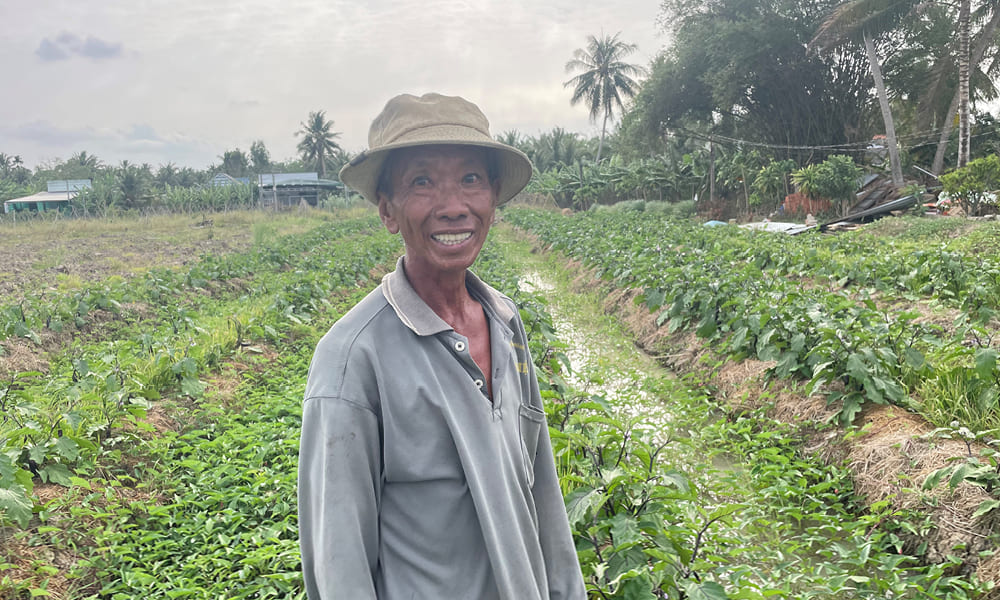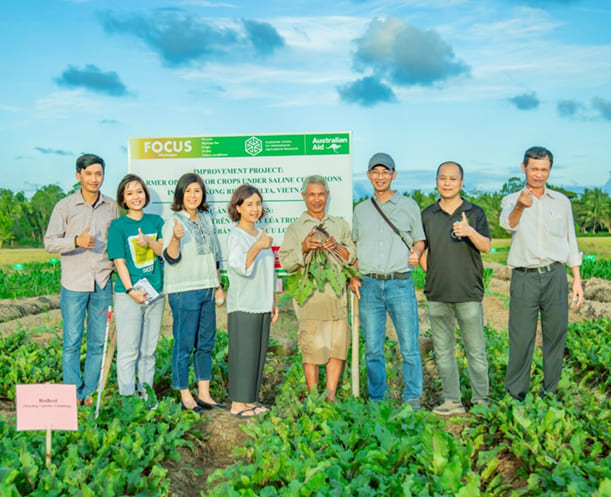Soil researchers at Charles Sturt University and Can Tho University in southern Vietnam are working together to plot a more productive path forward for rice farmers and their farms in the Mekong River Delta.
The traditional rice paddy family farms of the Mekong River Delta in Vietnam may seem a world away from the broadacre farming operations of the Australian outback, but the lessons learned here may hold the key to maintaining our food security in the face of climate change.

The Mekong River Delta is the food bowl of Vietnam. Over half of the country’s rice is grown there, with rice farming supporting around 80% of the region’s 19 million people. But rising sea levels and changing rainfall patterns are already changing their way of life. The Delta’s agricultural land is almost at sea level, and oceanic saline intrusion is progressing further inland each dry season. Tidal fluctuations, more frequent droughts, and decreases to river flow resulting from dams and increased water use in countries upstream are decreasing the amount of freshwater available and increasing soil salinity during the dry season.
Substantial rice crop losses are now a feature of the dry season in the Mekong River Delta. 2016 was particularly bad, with some provinces reporting 70% of the rice crop affected by salt and the remaining 30% dying, yielding no grain at all. 2020 saw severe drought and salinity affecting over 100,000 hectares as salt water intruded up to 70 km inland, again resulting in severe crop losses.
Despite trialling salt-tolerant rice varieties and sowing the dry season crop earlier to avoid salinity damage later in the season, crop failures have continued to occur. Without solutions to saline intrusion, farmers in areas traditionally growing three rice crops a year have been advised to limit production to only two wet season crops a year. This represents a significant loss to both food production and income for the farmers. As a result, there is a drive to explore alternative farming systems and crops with higher salt tolerances and lower water requirements than rice to grow during the dry season.
Building on a 20-year relationship, soil researchers at Charles Sturt University and Can Tho University in southern Vietnam are working together to plot a more productive path forward for rice farmers and their farms in the Delta. The Farmer Options for Crops Under Saline conditions project, or FOCUS, funded for over $2.3m by the Australian Centre for International Agricultural Research (ACIAR), aims to identify the impacts of rising soil salinity on soils, agricultural crops, people and food markets; evaluate alternative crops and soil management options for saline-affected areas; and identify cropping practices that provide the best livelihoods for farmers in the Delta region.
Associate Professor Jason Condon, a soil scientist in the Gulbali Institute, is focusing on glasshouse and field experiments to demonstrate how new crops and soil management technologies can meet the emerging conditions.
“We started by identifying the factors that alternative crops need to have to be suited to farming in the region,” explains Professor Condon. “Ideally, crops need to tolerate saline or water-restricted conditions, or have a short growing season allowing an early harvest before salinity and water restrictions become a problem in the late dry season. Plants that use water efficiently and minimise their dependence on irrigation, unlike rice, are also preferable.”
Crops also have to suit the growing duration and temperatures of the Mekong River Delta dry season, tolerate local diseases and pests, and be able to be grown and processed using existing farming equipment and labour. In particular, bed preparation may become critical prior to sowing alternative crops, as many crops do not tolerate the waterlogged conditions that can still exist at the start of the dry season in rice paddies.
Research areas: agriculture, soil science, climate change
Research problem: identifying and implementing alternative crop and management practices in areas affected by climate change
Collaborators/countries:
Outcomes: characterising the impact of salinity on crop-based farming systems, evaluating crop diversification and soil management options for saline affected areas
Impact: de-risking new crop and farming options for farmers, establishing the case for diversified food supply chains and markets in a changing climate
Beneficiaries: farmers and populations in areas affected by climate change, particularly salinity and drought.

A shortlist of potential crops was collected, with glasshouse growth studies undertaken in Australia for the more novel crops such as quinoa to test their suitability to conditions found in the Mekong River Delta. This was followed by field trials in Vietnam. “The farmers know things have changed, and they have been keen to work with us to help find the best way forward,” says Professor Condon. “We started with crops the farmers were familiar with, like watermelon and maize, before trialling more novel crops for the region like cowpea, quinoa and beetroot.”
Watermelon and maize grew well but needed a fair amount of fresh water, limiting their application.
The field trials were particularly informed by Australian farming experience with legumes. Professor Condon notes that “we know the additional benefits that legumes provide for soil health and nutrient availability for subsequent crops, so we tried cowpea, which was interesting. It has reasonable salt tolerance, good water use efficiency and reasonably short growth duration, but the farmers didn’t like growing it. You have to harvest a fresh crop of beans every day, which is a lot of repeat labour. The farmers were keen on the idea of legumes though, so we’re now considering forage legumes – those that you grow for soil nutrition as a green or brown manure crop, and for feeding livestock. That’s a possibility for a future phase of work.”
“We also tried quinoa, because it is short duration, salt tolerant, has good water use efficiency, and is high value. It looked promising, but turned out to be a high-risk option. Over the last few years the maximum temperature during the dry season has crept up, as the heat has moved later in the year. We might have had the occasional day over 35°C in the past, but in our last season of field experiments we had over a week where every day was over 35°C. Our quinoa grew nice and big, but that period of heat stopped it setting seed, so we had no product at the end of the season. If a 10-day heat window is enough to stop seed set, that’s too much of a risk for a farmer, we can’t predict that.”

Beetroot turned out to be a preferred crop, in terms of growth success. “It grows really fast, it is salt tolerant, and its water use efficiency is really good,” enthuses Professor Condon. “The crop tonnage is quite amazing too – about 40 tonnes per hectare, and it is quite high value.”
The FOCUS team also looked at soil management practices, to minimise the effects of salinity and maximise the survival chance and production of these new crops. Established Australian management techniques generally provided clear benefits, as Professor Condon details: “Raised beds are useful if you have the automation or labour to create them each season, because they improve drainage to help wash the salinity away, minimise waterlogging, and improve plant establishment”.
Mulching was also effective to minimise evaporation and maintain soil moisture, with straw mulch readily available as a byproduct from the wet season rice crops. Applying mulch could reduce topsoil salinity by 13% and increase the yield of alternative crops by up to 114%.
Optimising irrigation to maintain soil moisture while minimising water use became more of an educational activity than a scientific experiment. Professor Condon explains: “Traditional rice farmers work with flooded rice fields – they irrigate every day, because that’s what a good farmer does. So to grow these novel crops, we used Chameleon water sensors – an Australian-designed device that measures water tension in the soil and displays a colour-coded output to show the farmers when they need to irrigate. If it’s blue the soil is wet, if it’s green, it’s moist and they might need to irrigate tomorrow. If it’s red, it’s dry and time to irrigate. The farmers loved them because they didn’t need to spend hours irrigating every day – it saved them labour in pumping water, and fuel for the pumps. But importantly, along with mulch, it saved up to 50% of irrigation water without compromising crop yields.”
In practice, the farmers only needed the Chameleon water sensors for a season or two, as they learned for themselves how to read the crop and soil status to only irrigate when necessary.
By working out and demonstrating the factors that contribute to successful alternative high-value crops, the FOCUS project lessens the risks for farmers looking for alternatives to failing rice crops in the dry season. More broadly, it helps drive interest and confidence in private sector investment to develop supply chains and markets for these new crops.
“There are always risks involved in bringing in new crops, and farming in different ways,” says Professor Condon. “Failures are disappointing in a glasshouse or field trial, but they have larger implications when it’s a farmer’s livelihood. We can’t recommend the ‘optimal crop’ or method, because it needs to be suited to the local limitations, be that climate, water quality and availability, degree of farming automation and labour availability at scale, or even an available market for a new crop. But we can identify a range of crops and conditions and the evidence to support their introduction in different circumstances, to help farmers be successful, and for governments and markets to support that transition.”

Professor Condon and the FOCUS team may be working on diversifying farming systems to cope with climate change in Vietnam, but projects like these have implications closer to home too. “The Mekong River Delta is probably one of the worst areas in terms of how sea level rise and climate change is impacting farming, so we are ahead of the game working on the problems here,” he points out. “We can take this opportunity to show other countries what their future is going to look like – we can learn a lot from places like Vietnam.”
“Working in Vietnam gives us a fresh perspective and early access to what we’re increasingly finding are the same issues developing for farming in Australia. We should be looking at alternative crops here too, to provide evidence-based options for farmers in Australia that have problems with salinity, little water available for irrigation, or just the changing climate.”
The farmers of the Mekong River Delta are having to adapt to severe climate change impacts quickly, but these changes are gradually, steadily, occurring around the world. The lessons we learn from dry-season rice paddies in Vietnam will be useful for Australian farmers facing climate uncertainty and declining crop profitability closer to home.
Images (from top): Jason Condon and Dr Khoi; Mr Ky, a local farmer from Soc Trang, Vietnam that has taken the findings from the FOCUS project and created secure food production in the dry season, photo Jason Condon; A proud farmer; A visit of FOCUS project researchers and ACIAR Vietnam officers to the field trial, where rice straw mulch and Chameleons save irrigation water for beetroot production on paddy rice field in the dry season, photo ACIAR.
Charles Sturt University aligns our research, policies, procedures, and other work with the UN Sustainable Development Goals (SDGs). These are the most relevant SDGs for this initiative.